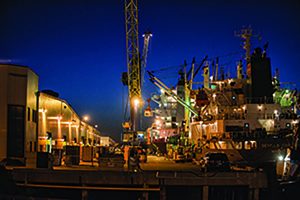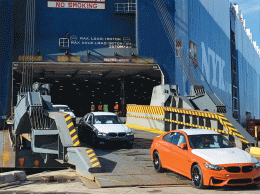The Port of Hueneme’s new long-term strategic plan calls for dredging a deeper channel so the port can handle more container ships.
The port also plans to increase its use of rail shipping and make other improvements to stay on the cutting edge of global trade.
The Oxnard Harbor District, which owns and operates the region’s only deepwater commercial port, held a meeting July 13 to gather public input on a draft of the 2020 Strategic Plan.
Port officials and consultants will revise it and return to the Board of Harbor Commissioners with a final version sometime in the next month or two, said Kristin Decas, the port’s CEO.
The harbor district’s goal is to keep growing the port’s business, which currently provides $1.1 billion a year in total economic activity, more than 10,000 direct and indirect jobs and $69 million a year in state and local tax revenue.
The port also wants to keep the advantages of speed and convenience that it has over the giant ports of Los Angeles and Long Beach.
Decas said the infrastructure improvements in the plan could total tens of millions of dollars over the coming decades.
In the past, she said, the port and its public and private-sector partners have spent comparable amounts on new and improved facilities: $56 million between 1988 and 2003, and another $19 million since 2003.
One proposed improvement is deepening the port’s channel and ship berths from 35 feet to 40 feet. A deeper channel would allow the port to accept more container ships, and it would allow some of the ships that currently dock there to do so without waiting for high tide, Decas said in an interview.
“They’re not making ships any smaller,” she said.
Decas said dredging the harbor to 40 feet should cost about $8 million. The U.S. Army Corps of Engineers should pay for most of that and leave the harbor district to pay for a little under $3 million, she said.
Both the Corps of Engineers and the harbor district have the money available, she said, and the project could be funded in the next fiscal year. The sand could be sent to Hueneme Beach, which has lost sand at an alarming rate in recent years.
“Deepening the harbor is absolutely critical for the Port of Hueneme to compete with other ports,” Don Asdell, CEO of auto importer Global Auto Processing Services, told the board July 13.
The meeting drew importers and exporters, executives of chambers of commerce and other business organizations, and officials with the city of Port Hueneme and other neighboring governments.
Decas said before the meeting that the city’s participation is a good sign, given that just last year the harbor district and city council were fighting over a failed city ballot measure that would have raised business taxes for port customers.
“There is an active dialogue with the city, and we’re very encouraged by that,” Decas said.
Nancy Lindholm, CEO of the Oxnard Chamber of Commerce, told the board she was happy to see the harbor district trying to attract more container ships.
Most cargo that arrives now is either automobiles that are driven off the ships, or “break-bulk” cargo that arrives in packages much smaller than containers.
“I’m excited to see that happen,” Lindholm said. “I think it opens the port to all kinds of markets that aren’t there now.”
There were also residents of the neighborhoods near the port at the meeting, and some of them objected to the harbor district’s plans to make more use of the rail line that runs from the port to the main Union Pacific line in Oxnard.
“It is an asset to the harbor,” Decas told one concerned resident. “We do have active rail, but there isn’t cargo running on that line that goes to Oxnard. It is part of our strategic review to see how to maximize those assets.”






 Print
Print Email
Email

















